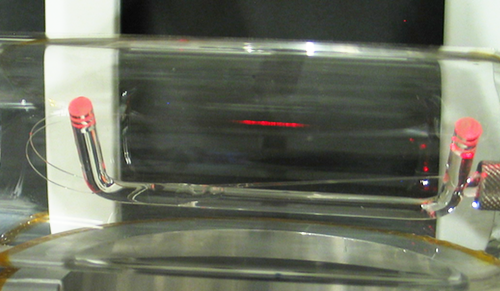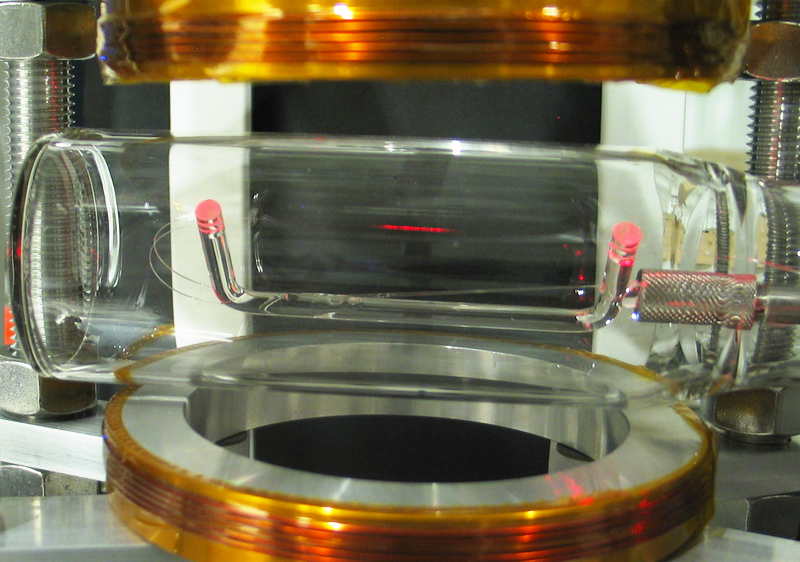Strong Light Reflection from Few Atoms
Two independent research teams report what must surely be the lightest, most insubstantial mirrors ever made. They have both reflected a significant amount of laser light from just one or two thousand atoms. The atomic mirrors might be useful for controlling light signals in photonic circuits. And because the mirror atoms interact strongly with one another, they might serve as an analog system for simulating the behavior of solids at the quantum-mechanical level.
Mirrors are essential components in photonic technology, not least as key components of lasers. But an ability to control the interactions between light and individual atoms can also provide new fundamental insights into quantum physics and might be useful for quantum-based information technologies such as quantum computing.
The new work involves Bragg reflection, the phenomenon whereby waves reflecting from regularly spaced scatterers (such as atoms in a crystal) can reinforce one another at specific angles that depend on the wavelength. When the waves are strongly Bragg-reflected directly back in the incident direction (because the spacing of scatterers matches half the wavelength or multiples thereof), the system acts like a mirror. Artificial Bragg mirrors made from stacked thin films of materials are commonly used in optical technologies such as miniaturized lasers.
Previous attempts to reflect light from clouds of trapped atoms required millions of atoms to get appreciable reflectance. Now a team led by Julien Laurat of the Pierre and Marie Curie University in Paris and another team at the University of Copenhagen led by Jürgen Appel have both made Bragg mirrors from small numbers of atoms. The atoms were held in a straight line of regularly spaced, single-atom traps called an optical lattice, which is produced by standing waves of intense laser light. The teams created their one-dimensional traps close to optical fibers that carried the trapping light beams. This arrangement permits strong interactions between the atoms and the incident light beam; in previous experiments, there was no optical fiber, and the trapping beams simply propagated freely through the chamber containing the atoms.
The technique relies on using very thin fibers, just a few hundred nanometers in diameter. In these fibers, a lot of the light leaks out just beyond it, in a so-called evanescent field. “For such small fiber diameters, the light is essentially guided along the fiber rather than within it,” explains Appel. Depending on the wavelength, around a third of the light power may be outside the fiber.
The evanescent field can then serve as an optical lattice to trap atoms just outside the fiber. The teams created an optical lattice with red or infrared light, which positioned the atoms at spacings of several hundred nanometers. To prevent the atoms from being drawn toward the fiber surface, both teams used a second beam of red light to push them gently outward.
The reflectance of these atomic Bragg mirrors can be measured by sending a third beam of light into the fiber and seeing how much of it bounces back toward the source. Appel and colleagues estimate that their trap contained around 1300 cesium atoms in all, and they found that the trapped atoms can reflect more than 10% of the probe beam—more than is reflected by a typical slab of window glass. Laurat and colleagues, meanwhile, saw about three-quarters of the beam intensity being scattered directly backwards from their mirror, which, their calculations imply, contained around 2000 atoms. The reflectivity achieved by the French team was higher not just because their traps contained more atoms but also because they could more reliably ensure that all the atoms involved in light scattering were at the right positions for Bragg reflection.
One of the benefits of an “atomic mirror,” says Laurat, is that it could be switched on and off with extremely weak light signals; just a few photons could pump the atoms into nonreflecting states. These atomic arrangements could also have benefits beyond their function as mirrors, the researchers say. The close coupling between the trapping field and the atoms’ internal states means that the atoms can “feel” one another sensitively via the optical lattice, and they interact over a relatively long range. In principle, the atomic array could then act as an analog system for simulating certain kinds of condensed-matter systems and might be used as a system of coupled quantum bits for quantum computing. Both teams stress, however, that such applications would require even stronger interaction between the atoms and the light in the fiber.
Quantum optics expert Tilman Esslinger of the Swiss Federal Institute of Technology (ETH) in Zurich says that the results represent an impressive technical achievement but adds that the experiments “still have some way to go” before they are ready to be used for quantum information or simulations. Wolfgang Ketterle of the Massachusetts Institute of Technology, a specialist in cold-atom physics and quantum optics, says that the papers both report “a major advance in engineering and controlling how atoms scatter light.”
This research is published in Physical Review Letters.
–Philip Ball
Philip Ball is a freelance science writer in London. His latest book is How Life Works (Picador, 2024).





